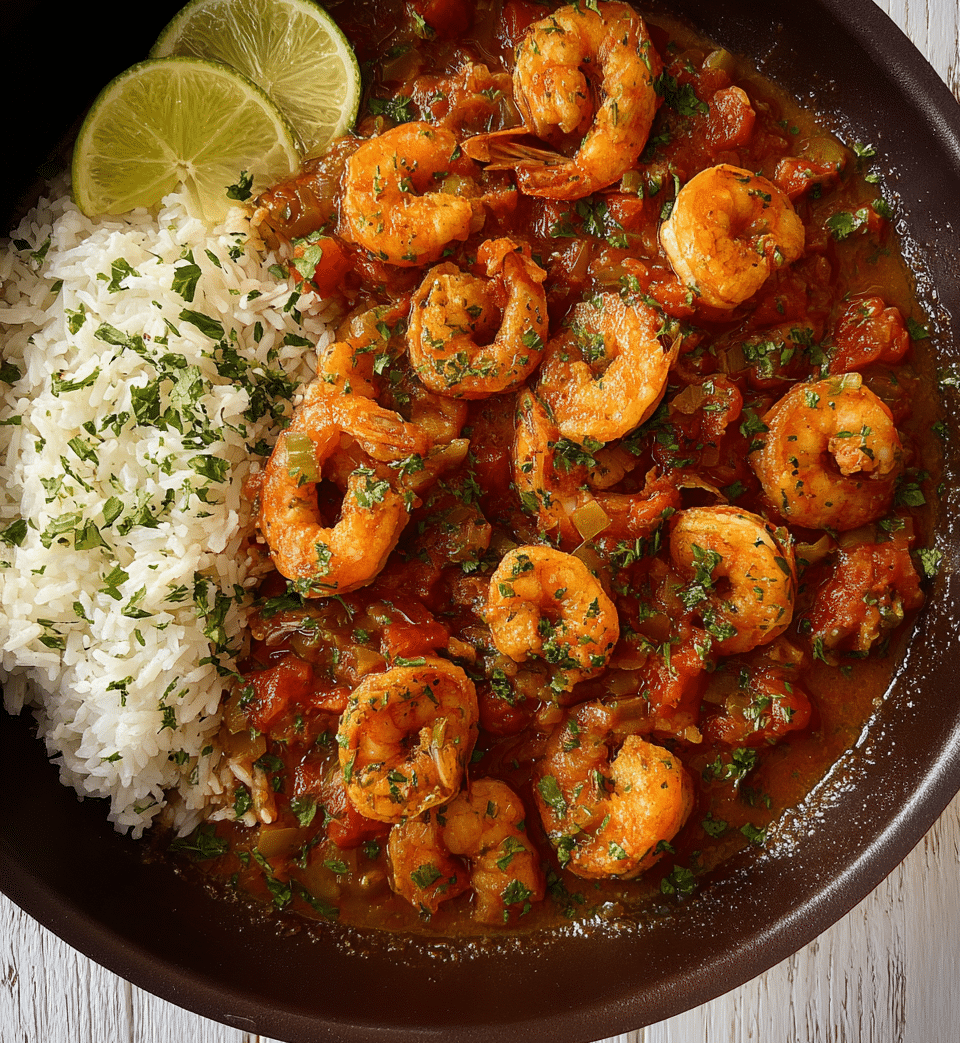A classic Louisiana dish, Shrimp Creole combines succulent shrimp with a flavorful tomato-based sauce, seasoned with the “holy trinity” of Creole cooking—onion, celery, and bell pepper. This dish is typically served over steamed white rice, offering a comforting and spicy meal.
Ingredients
-
2 lbs large or jumbo shrimp, peeled and deveined
-
6 tbsp unsalted butter
-
1 medium onion, finely chopped
-
1 medium bell pepper, finely chopped
-
2 celery stalks, finely chopped
-
4 cloves garlic, minced
-
1 (14.5 oz) can diced tomatoes
-
2 tbsp tomato paste
-
1 tsp paprika
-
1 tsp dried oregano
-
1 tsp dried thyme
-
1/2 tsp cayenne pepper (adjust to taste)
-
Salt and black pepper to taste
-
2 tbsp chopped fresh parsley
-
Steamed white rice, for serving
Directions
-
In a large skillet, melt the butter over medium heat.
-
Add the chopped onion, bell pepper, and celery (the “holy trinity”) to the skillet.
-
Sauté the vegetables until they are soft and translucent, about 5-7 minutes.
-
Add the minced garlic and cook for an additional 1 minute until fragrant.
-
Stir in the diced tomatoes, tomato paste, paprika, oregano, thyme, cayenne pepper, salt, and black pepper.
-
Simmer the sauce for 10-15 minutes, allowing it to thicken slightly.
-
Add the shrimp to the skillet and cook until they turn pink and are cooked through, about 5-7 minutes.
-
Stir in the chopped parsley just before serving.
-
Serve the Shrimp Creole over steamed white rice.
Nutritional Information (per serving)
-
Calories: Approximately 300 kcal
-
Protein: 25g
-
Fat: 18g
-
Carbohydrates: 15g
-
Fiber: 3g
-
Sodium: 800mg
Creole vs. Cajun: Understanding the Differences
While both Creole and Cajun cuisines share similarities, they are distinct culinary traditions with their own histories, techniques, and ingredients. Understanding the differences between these two types of cooking can help deepen your appreciation for dishes like Shrimp Creole.
Creole cuisine, as mentioned earlier, has its roots in New Orleans and is influenced by French, Spanish, African, and Native American culinary traditions. It tends to be more refined and features ingredients that were historically available in urban settings. Creole dishes often incorporate tomatoes, butter, and a variety of herbs and spices, with sauces being rich and well-seasoned. Shrimp Creole, with its tomato-based sauce and the use of the holy trinity, is an excellent example of this style of cooking.
On the other hand, Cajun cuisine originates from rural Louisiana, specifically from the Acadiana region, and is rooted in the French-speaking Acadian culture. Cajun cooking is known for its bold, rustic flavors and the use of ingredients such as rice, crawfish, and pork. It is also known for its spicier profile, often incorporating hot peppers and a variety of seasonings like garlic and bay leaves. While both Creole and Cajun foods are flavorful and spicy, Cajun dishes tend to have a heartier, more robust flavor, whereas Creole dishes are often lighter and more nuanced.
The Key Ingredients in Shrimp Creole
Shrimp Creole is defined by a few essential ingredients that work together to create the dish’s signature flavor. Understanding these ingredients is key to mastering the dish.
-
Shrimp: As the star of the dish, shrimp are the focal point. They should be fresh, peeled, and deveined for optimal taste and texture. While large or jumbo shrimp are often preferred, smaller shrimp can also be used.
-
The Holy Trinity (Onions, Celery, Bell Peppers): This combination of vegetables is the base for many Creole dishes. The natural sweetness of the onions, the mild bitterness of the celery, and the slightly tangy flavor of bell peppers create a harmonious balance of flavors.
-
Tomatoes: The backbone of the sauce in Shrimp Creole is the tomato. Diced tomatoes or crushed tomatoes form the foundation of the dish’s rich, slightly tangy sauce, while tomato paste adds depth of flavor.
-
Garlic: Garlic brings an aromatic punch to the dish and pairs beautifully with the other vegetables and spices. It’s often sautéed with the holy trinity for maximum flavor.
-
Spices and Herbs: The seasonings used in Shrimp Creole—such as paprika, cayenne pepper, oregano, and thyme—are essential to the dish’s Creole identity. Paprika provides smokiness, while cayenne adds heat. Oregano and thyme contribute earthy, savory notes to the dish.
-
Butter: Butter serves as the fat in this dish, offering richness and a smooth texture to the sauce. It helps sauté the vegetables and infuses the dish with a luxurious mouthfeel.
Variations of Shrimp Creole
While the classic Shrimp Creole recipe is beloved for its simplicity and traditional flavors, there are several ways to customize the dish to suit personal tastes or dietary preferences. Here are a few popular variations:
-
Spice Levels: The heat in Shrimp Creole can be adjusted according to personal preference. If you prefer a milder dish, reduce the amount of cayenne pepper or omit it altogether. For those who love heat, consider adding hot sauce or more cayenne for an extra kick.
-
Additional Vegetables: While the holy trinity (onion, celery, and bell pepper) is a key component, you can also add other vegetables like tomatoes, okra, or even zucchini for added texture and flavor.
-
Tomato Sauce vs. Diced Tomatoes: While diced tomatoes are traditional, some people prefer using tomato sauce or crushed tomatoes for a smoother, more uniform consistency in the sauce. Experimenting with different types of tomatoes can subtly change the dish’s overall flavor.
-
Serving Options: Although Shrimp Creole is commonly served over white rice, it can also be paired with other grains like brown rice, quinoa, or even pasta for a different texture and flavor profile.
-
Vegetarian Version: For a vegetarian variation of Shrimp Creole, consider substituting the shrimp with plant-based alternatives like tofu or tempeh. Alternatively, a medley of hearty vegetables like eggplant or mushrooms can be used to create a satisfying, meat-free dish.
Pairing Shrimp Creole with Sides and Drinks
Shrimp Creole is a flavorful and filling dish that pairs beautifully with a variety of side dishes and beverages. Here are a few ideas to complement your meal:
-
Side Dishes: Traditional sides that go well with Shrimp Creole include a simple green salad, cornbread, or roasted vegetables. Steamed or sautéed greens, such as collard greens or spinach, also make an excellent pairing. For a richer option, try serving the dish with buttery garlic bread.
-
Beverages: Since Shrimp Creole has a robust flavor profile, it pairs well with refreshing, slightly acidic beverages. White wine, particularly a crisp Sauvignon Blanc or Chardonnay, works well to cut through the richness of the sauce. For a non-alcoholic option, consider serving iced tea with lemon or a refreshing cucumber mint cooler.
Health Considerations
Shrimp Creole is a relatively healthy dish, especially when prepared with fresh ingredients and served with steamed rice. The shrimp provides lean protein, while the vegetables add fiber and essential vitamins. The use of herbs and spices contributes not only flavor but also potential health benefits. For example, cayenne pepper is thought to boost metabolism, and garlic is known for its antioxidant properties.
However, it’s important to keep in mind that the dish can be high in sodium due to the use of canned tomatoes and seasonings. For a lower-sodium version, consider using fresh tomatoes and adjusting the amount of salt used in the recipe.
Conclusion
Shrimp Creole is a beloved Louisiana classic that showcases the bold, flavorful, and multicultural essence of Creole cuisine. With its tender shrimp, rich tomato sauce, and aromatic vegetables, this dish offers a delightful balance of heat, sweetness, and savory goodness. Whether you’re preparing it for a weeknight dinner or a special occasion, Shrimp Creole is a satisfying and versatile meal that can be customized to suit different tastes. By understanding the dish’s history, key ingredients, and potential variations, you can make this iconic recipe your own while celebrating the rich culinary traditions of New Orleans.






